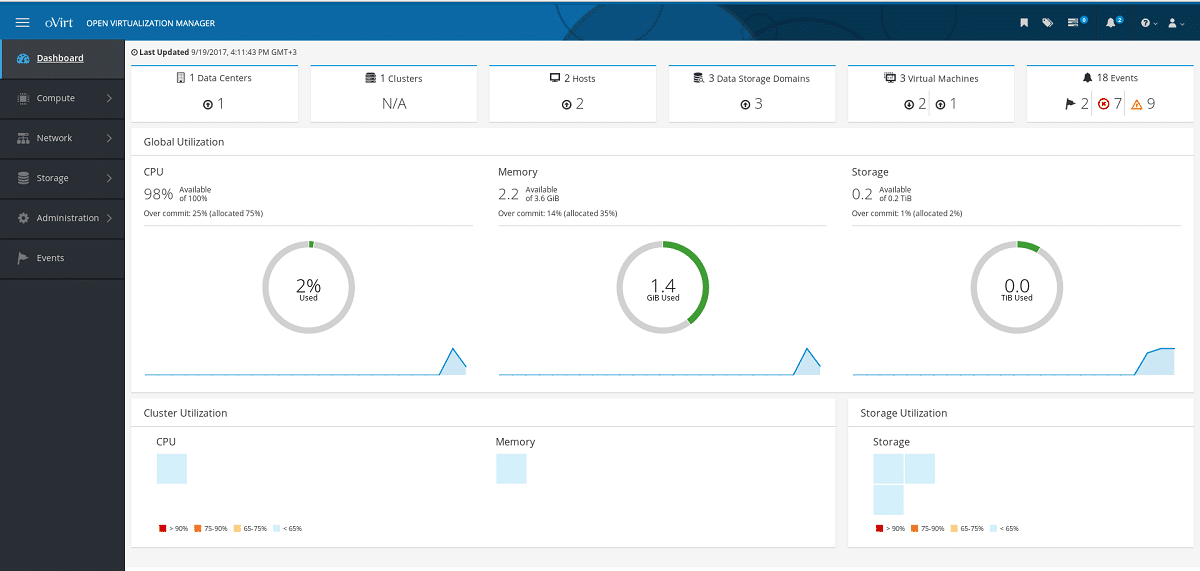
oVirt is a platform for deploying, maintaining and monitoring virtual machines and managing cloud infrastructure based on the KVM hypervisor and libvirt library.
Basically, oVirt is a virtualization solution distributed open source designed to manage the entire infrastructure of a company. oVirt uses the trusted KVM hypervisor and is based on several other community projects, including libvirt, Gluster, PatternFly, and Ansible.
The virtual machine management technologies developed in oVirt are used in the Red Hat Enterprise Virtualization product and can act as an open alternative to VMware vSphere. In addition to Red Hat, Canonical, Cisco, IBM, Intel, NetApp and SUSE are also involved in development.
About oVirt
oVirt is a stack that covers all levels of virtualization, from the hypervisor to the API and GUI. Although KVM is positioned as the main hypervisor in oVirt, the interface is implemented as a plugin to the libvirt library, which abstracts from the hypervisor type and is suitable for managing virtual machines based on various virtualization systems, including Xen and VirtualBox.
As part of oVirt, an interface for rapid mass creation of highly available virtual machines with support for live migration of environments between servers without stopping work is being developed.
Platform provides tools to create dynamic balancing rules and manage resources tools, cluster power management mechanisms, virtual machine image management tools, and components for converting and importing existing virtual machines. A single virtual datastore is supported, accessible from any node.
The interface contains advanced reporting and management tools that allow you to manage settings both at the infrastructure level and at the level of individual virtual machines.
Within of the characteristics that can be highlighted from oVirt, are the following:
- Rich web-based user interfaces for admin and non-admin users
- Integrated management of hosts, storage and network settings
- Live migration of virtual machines and disks between hosts and storage
- High availability of virtual machines in case of host failure
In addition, it is worth mentioning that the platform recently updated to oVirt version 4.5.0, in which the most notable novelties are the following:
- Provided support for CentOS Stream 8 and RHEL 8.6-beta.
- Experimental support implemented for CentOS Stream 9.
- Updated versions of components used, including GlusterFS 10.1, RDO OpenStack, Yoga, OVS 2.15, and Ansible Core 2.12.2.
- Native IPSec support has been implemented for hosts with an Open Virtual Network (OVN).
- Virtual Network) and a configured ovirt-provider-ovn package.
- Added support for the Virtio 1.1 specification.
- Provided the ability to enable NVIDIA Unified Memory technology for virtual GPUs (mdev vGPU).
- Export to OVA (Open Virtual Appliance) using NFS has been sped up.
- Added a search feature to the vNIC Profiles tab in the web interface.
- Improved notification of upcoming certificate obsolescence.
- Added support for Windows 2022.
- For hosts, the nvme-cli package is included.
- Provided automatic CPU and NUMA binding during migration.
- The ability to switch storage to maintenance mode with freezing of virtual machines has been provided.
- Fixed 9 vulnerabilities, 8 of which are assigned a Moderate severity level and one is assigned a Low severity level. The main problems are related to cross-site scripting (XSS) in the web interface and denial of service in the regular expression engine.
Download and get oVirt
Finally if you are iInterested in learning more about it of this platform, you should know that the code of the project is distributed under the GPLv2 license and you can consult more about it in the following link
As for those interested in power try this platform you should know that Ready packages are available for CentOS Stream 8 and Red Hat Enterprise Linux 8.6 Beta. A ready-to-deploy ISO image of oVirt Node NG based on CentOS Stream 8 and you can get them from the following link.